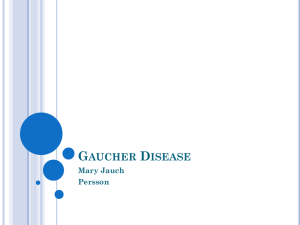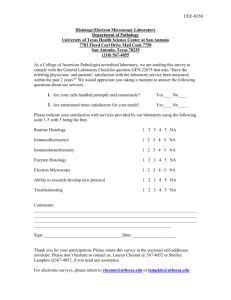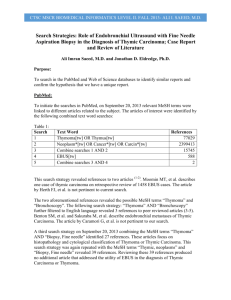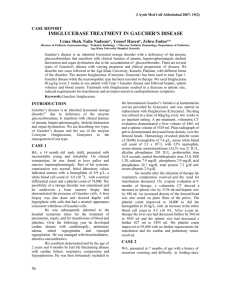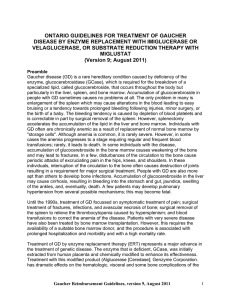Hruban - Pathology
advertisement
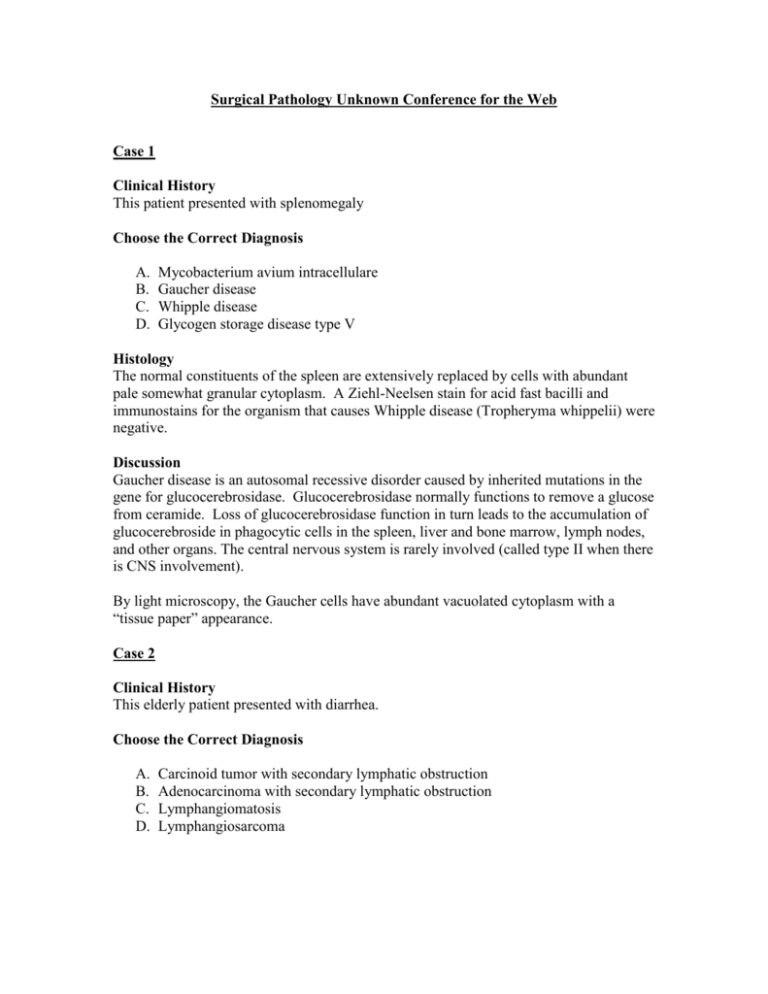
Surgical Pathology Unknown Conference for the Web Case 1 Clinical History This patient presented with splenomegaly Choose the Correct Diagnosis A. B. C. D. Mycobacterium avium intracellulare Gaucher disease Whipple disease Glycogen storage disease type V Histology The normal constituents of the spleen are extensively replaced by cells with abundant pale somewhat granular cytoplasm. A Ziehl-Neelsen stain for acid fast bacilli and immunostains for the organism that causes Whipple disease (Tropheryma whippelii) were negative. Discussion Gaucher disease is an autosomal recessive disorder caused by inherited mutations in the gene for glucocerebrosidase. Glucocerebrosidase normally functions to remove a glucose from ceramide. Loss of glucocerebrosidase function in turn leads to the accumulation of glucocerebroside in phagocytic cells in the spleen, liver and bone marrow, lymph nodes, and other organs. The central nervous system is rarely involved (called type II when there is CNS involvement). By light microscopy, the Gaucher cells have abundant vacuolated cytoplasm with a “tissue paper” appearance. Case 2 Clinical History This elderly patient presented with diarrhea. Choose the Correct Diagnosis A. B. C. D. Carcinoid tumor with secondary lymphatic obstruction Adenocarcinoma with secondary lymphatic obstruction Lymphangiomatosis Lymphangiosarcoma Histology Two processes are seen. The first is a widely disseminated well-differentiated neoplasm with lymphatic invasion. The second is dilation of the lymphatics in the bowel. Discussion This is a dramatic case of a carcinoid tumor extensively involving the lymphatics of the bowel with secondary lymphostasis. Microscopically, carcinoid tumors are characterized by nests of well-differentiated cells with uniform round nuclei. The nuclei have a “salt and pepper” chromatin pattern. Small bowel carcinoids less than 2 cm without angioinvasion are generally benign, but, as demonstrated in this case, those > 2 cm and those with angioinvasion can follow a malignant course. Case 3 Clinical History This 43 year old presented with weight loss. Choose the Correct Diagnosis A. B. C. D. E. Cryptosporidiosis Microsporidiosis Giardia Strongyloides Entamoeba Histology Numerous parasites are seen in this biopsy of the gastrointestinal tract. Discussion Helininths can cause a variety of diseases in humans. Helminths have complex life cycles, although most adult worms do not multiphy in humans. Strongyloides is an exception to this as autoinfection can occur. Strongyloidiasis occurs primarily in tropical and temperate climates. The free-living adult female measures 1 mm and the parasitic female 2-3 mm in length. Eggs measures 50 to 60 microns in length. Adult female worms inhabit the crypts of the small intestine. It is there that the females deposit eggs. Reference: Pathology of Tropical and Extraordinary Disease, C.H. Binford and D.H. Conner, Armed Forces Institute of Pathology. Case 4 Clinical History This middle aged person presented with a supraclavicular mass. Choose the Correct Diagnosis A. B. C. D. E. Ectopic hamartomatous thymoma Metastatic breast carcinoma Metastatic prostate cancer Mesothelioma Synovial sarcoma Histology This well-circumscribed lesion is composed of short fascicles of histologically bland spindle-shaped cells, epithelial cells forming anastomosing cords, and a small amount of fat. Discussion Ectopic hamartomatous thymoma is a rare benign neoplasm composed of a mixture of epithelial cells, spindle-shaped cells and fat. This lesion can occur in the supraclavicular area and the lesions typically contain CD99 positive lymphocytes, and the spindle cells express CD10 and alpha-smooth muscle actin. References: Lee, SN, et al. Ectopic hamartomatous thymoma: a case report showing CD99 lymphocytes and a low proliferation index. Arch Pathol Lab Med. 2003; 127:37881. Fukunaga M. Ectopic hamartomatous thymoma: a case report with immunohistochemical and ultrastructural studies. APMIS. 2002; 110:565-570. Case 5 Clinical History This immunocompromised patient presented with diarrhea. Choose the Correct Diagnosis A. B. C. D. Mycobacterium avium intracellulare Gaucher disease Whipple disease Glycogen storage disease type V Histology Numerous foamy macrophages are present within the lamina propria of this biopsy. A Ziehl-Neelsen stain revealed numerous acid fast organisms. Discussion This is a straightforward case of mycobacterium avium-intracellulare complex (MAI) involving the gut. I put it on to contrast with Case #1, the case of Gaucher disease. Note the differences in the appearance of the foam cells on hematoxylin and eosin staining. In Gaucher disease, the foam cells have a “tissue paper” appearance, while in MAI the cytoplasm is more granular. Special stains are needed to establish the diagnosis. Case 6 Clinical History This elderly man presented with a mass in the head of the pancreas. Choose the Correct Diagnosis A. B. C. D. E. Pancreatic intraepithelial neoplasia-1 Pancreatic intraepithelial neoplasia-2 Pancreatic intraepithelial neoplasia-3 Infiltrating adenocarcinoma Intraductal papillary mucinous neoplasm Histology The lesion highlighted is composed of a well-differentiated glandular epithelium with minimal atypia. While it could represent a low-grade PanIN, the VVG stain reveals that these epithelial cells are within a blood vessel. Discussion Invasive adenocarcinoma of the pancreas, in addition to invading nerves, often invades blood vessels. When they do they can form a tumor thrombus or the neoplastic cells can line the wall of the blood vessel. This latter pattern can be very striking, with the neoplastic cells appearing to replace the endothelial cells. This pattern of vascular involvement is important to recognize because it can mimic a PanIN lesion or an IPMN.
